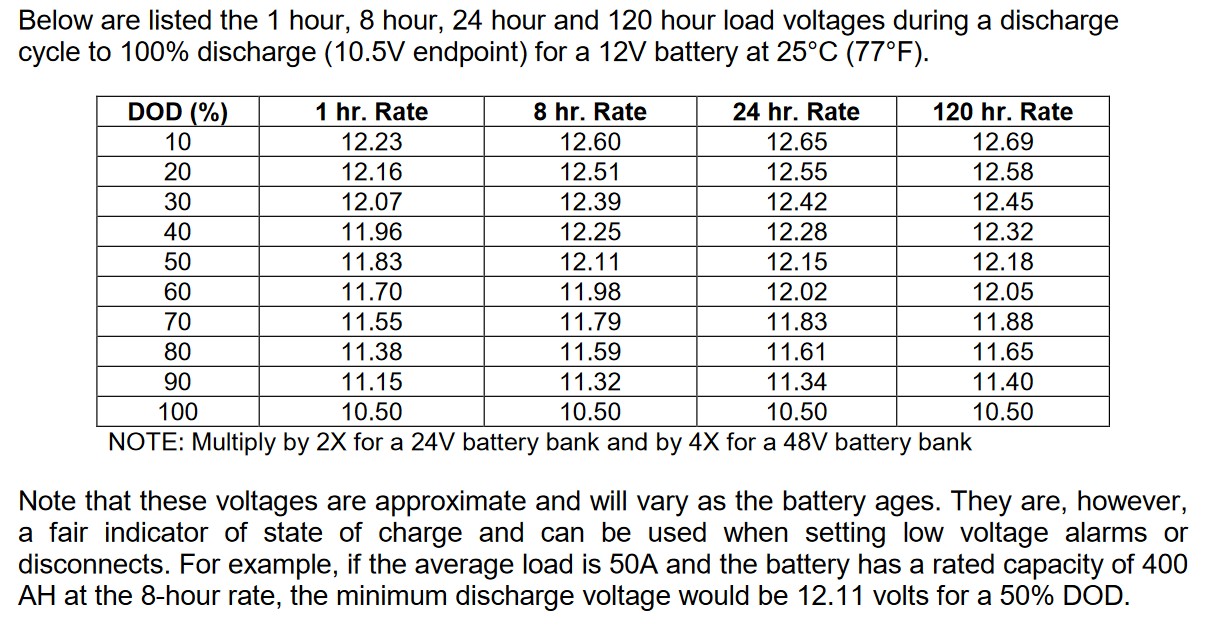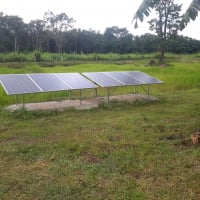How to determine max healthy intermittent load for battery bank?
jdobush
Registered Users Posts: 18 ✭✭
Hi all,
I'm putting the finishing touches on designing a new battery bank for my existing off grid system. Without getting crazy into details - my previous battery bank was both too small and with very short lived AGM batteries. I'm spending the time now doing many different calculations of my loads and system, and making sure depth of discharge can stay within a 30% window the majority of the time.
My question here is - how do you determine the maximum intermittent (but regular) load of a given battery bank? This is one calculation I can't find a concrete answer for just opinions.
Case in point - I run my well pump off of my setup. Some days it doesn't run at all. Other days when we are active, it can run 8 or 10 times through out the day. Each time only runs for 2 minutes roughly. (draws 1200 watts running average +greater startup) Usually these greater use days total maybe 0.25 to 0.5 kwh per day. That alone is next to nothing, but most battery bank calculators don't ask anything other than daily watt hours to calculate depth of discharge.
My batteries (whats left of them) say maximum 500amps intermittent discharge (crazy but no other guideline). And my wiring and inverter are well within range. So what is your chosen maximum (for a couple minutes) draw from your battery bank? A 20 hour rate? 10 hour? 1 hour? How does this ultimately affect the life of your batteries?
Thanks! Jim
I'm putting the finishing touches on designing a new battery bank for my existing off grid system. Without getting crazy into details - my previous battery bank was both too small and with very short lived AGM batteries. I'm spending the time now doing many different calculations of my loads and system, and making sure depth of discharge can stay within a 30% window the majority of the time.
My question here is - how do you determine the maximum intermittent (but regular) load of a given battery bank? This is one calculation I can't find a concrete answer for just opinions.
Case in point - I run my well pump off of my setup. Some days it doesn't run at all. Other days when we are active, it can run 8 or 10 times through out the day. Each time only runs for 2 minutes roughly. (draws 1200 watts running average +greater startup) Usually these greater use days total maybe 0.25 to 0.5 kwh per day. That alone is next to nothing, but most battery bank calculators don't ask anything other than daily watt hours to calculate depth of discharge.
My batteries (whats left of them) say maximum 500amps intermittent discharge (crazy but no other guideline). And my wiring and inverter are well within range. So what is your chosen maximum (for a couple minutes) draw from your battery bank? A 20 hour rate? 10 hour? 1 hour? How does this ultimately affect the life of your batteries?
Thanks! Jim
Comments
-
Welcometo the forum Jim
Lead acid batteries can support extremely high current demands but suffer voltage drop, the larger the nominal battery capacity the lower the voltage drop. Since neither the battery capacity not the nominal voltage is supplied it's not possible for others to make helpful suggestions.
To get some idea of suitably measure the battery voltage at pump startup and during running, the initial surge on startup will drop the voltage to its lowest value, then voltage should recover to a higher value. For example if the nominal voltage is 12V, the battery is fully charged resting at 12.5V, when the pump starts the voltage may initially drop to 11.5V then return to 12.2V, if it can maintain that value during the 2 minutes run time, then return to 12.3-12.4V the battery capacity would be sufficient, if values are significantly lower more capacity may be needed.
For offgrid the 20 hour rate is commonly used this is because the window of charging opportunity is limited to ~4 hours , the actual amount of energy used by the pump running for a few minutes is relitivly low, 2 minutes as a decimal of an hour is 0.033, so 1200W × 0.033 = 39.6 Wh, a 12V 100Ah battery has 1,200 Wh (600Wh at 50% maximum recommend discharge) so theroitically the pump could run ~15 times for 2 minutes before it is discharged to 50%.
1500W, 6× Schutten 250W Poly panels , Schneider MPPT 60 150 CC, Schneider SW 2524 inverter, 400Ah LFP 24V nominal battery with Battery Bodyguard BMS
Second system 1890W 3 × 300W No name brand poly, 3×330 Sunsolar Poly panels, Morningstar TS 60 PWM controller, no name 2000W inverter 400Ah LFP 24V nominal battery with Daly BMS, used for water pumping and day time air conditioning.
5Kw Yanmar clone single cylinder air cooled diesel generator for rare emergency charging and welding. -
Thanks for the reply. Apologies, I hadn't included my current bank size which is 24v 400ah AGM. Currently planning on moving to 24v 600ah, which will better support my usage overall.
The voltage drop you mentioned is some of my concern. I'm currently hitting my low voltage cutoff (10.5v) every once in a while during that startup surge, after discharging overnight. (again, these batteries are seriously sulfated and won't hold more than a surface charge, its why I'm replacing them) I measured the voltage drop the other day when close to fully charged and had some minimal solar still coming in hence the high starting voltage - starting V 26.5v, initial spike 25.18v, returning to 25.5 ish but dropping steadily. I know I can't compare my current numbers to a new bank, since this bank at one time for a year or two handled it just fine.
So that's all well and good being able to watch the voltage drop - but I'm trying to figure this out for a new theoretical battery system. Is it possible to calculate what the voltage drop should be for a given load? Or other ways to plan out a max load? Maybe it is just opinion based, but I know it would be crazy to hit this bank with 500 amps occasionally - so where's the line? Is it really just hardware limitations?
-
This data is for Concorde AGM batteries. It will allow you to project battery voltage vs. SOC vs. Load. You should get the data for your specific brand because AGM batteries because the numbers could be drastically different.
 I always have more questions than answers. That's the nature of life.
I always have more questions than answers. That's the nature of life. -
Since you are redesigning, you might consider the current pumping scheme. Really a much better strategy (in many ways) offgrid and in winter where we concentrate, is running this well load near noon and using a smaller softstart pump for house supply from a 300 gallon or larger house tank. Winter is where it all happens offgrid!
."we go where power lines don't" Sierra Nevada mountain area
htps://offgridsolar1.com/
E-mail offgridsolar@sti.net -
Thanks - this is kind of what I had in mind, but I've yet to find it for my current or new batteries, I will go back to looking now that I have an example of what to look for. (this charts drops shown aren't as bad as I feared)Marc Kurth said:This data is for Concorde AGM batteries. It will allow you to project battery voltage vs. SOC vs. Load. You should get the data for your specific brand because AGM batteries because the numbers could be drastically different.
Still curious as to how regularly hitting for instance that 1 hr or 8 hr rate affects the overall life of a lead acid battery. I have to believe there is some loss of life/efficiency long term more than just the immediate peukerts effect.
Edit now that I think about it - I guess I'm asking more on the terms that a starting battery with normally deal with. But considering 50ish amps from a bank compared to a couple hundred from a starter seems fairly insignificant. -
Right, I know there are plenty better options out there, but for now I feel it's more responsible to use what I have until the end of it's life. I'd love to work in a rain water collection system as well if i go to a tank storage system.Dave Angelini said:Since you are redesigning, you might consider the current pumping scheme. Really a much better strategy (in many ways) offgrid and in winter where we concentrate, is running this well load near noon and using a smaller softstart pump for house supply from a 300 gallon or larger house tank. Winter is where it all happens offgrid!
. -
18,000 gallons of rain in the tanks, almost full!"we go where power lines don't" Sierra Nevada mountain area
htps://offgridsolar1.com/
E-mail offgridsolar@sti.net
Categories
- All Categories
- 233 Forum & Website
- 141 Solar Forum News and Announcements
- 1.4K Solar News, Reviews, & Product Announcements
- 199 Solar Information links & sources, event announcements
- 900 Solar Product Reviews & Opinions
- 256 Solar Skeptics, Hype, & Scams Corner
- 22.5K Solar Electric Power, Wind Power & Balance of System
- 3.5K General Solar Power Topics
- 6.7K Solar Beginners Corner
- 1K PV Installers Forum - NEC, Wiring, Installation
- 2.1K Advanced Solar Electric Technical Forum
- 5.6K Off Grid Solar & Battery Systems
- 429 Caravan, Recreational Vehicle, and Marine Power Systems
- 1.1K Grid Tie and Grid Interactive Systems
- 656 Solar Water Pumping
- 816 Wind Power Generation
- 624 Energy Use & Conservation
- 623 Discussion Forums/Café
- 315 In the Weeds--Member's Choice
- 75 Construction
- 125 New Battery Technologies
- 108 Old Battery Tech Discussions
- 3.8K Solar News - Automatic Feed
- 3.8K Solar Energy News RSS Feed

